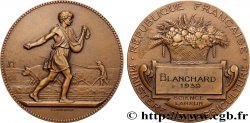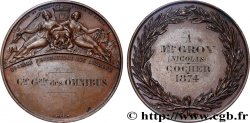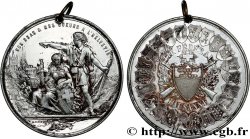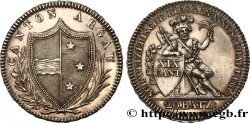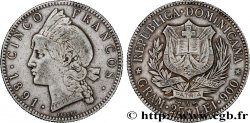You must signin and be an approved bidder to bid, LOGIN TO BID. Accounts are subject to approval and the approval process takes place within 48 hours. Do not wait until the day a sale closes to register. Clicking on "BID" constitutes acceptance of the terms of use of cgb.fr private live auctions.
Bids must be placed in whole Euro amounts only. The sale will start closing at the time stated on the item description; any bids received at the site after the closing time will not be executed. Transmission times may vary and bids could be rejected if you wait until the last second. For further information check the Live auction FAQ
All winning bids are subject to a 18% buyer’s fee.
All winning bids are subject to a 18% buyer’s fee.
| Estimate : | 600 € |
| Price : | 1 250 € |
| Maximum bid : | 1 300 € |
| End of the sale : | 04 March 2025 17:32:05 |
| bidders : | 4 bidders |
Type : Médaille, Fuller, Loïe, n°59
Date: 1900
Quantity minted : 275
Metal : silver
Diameter : 71,5 mm
Orientation dies : 12 h.
Engraver ROCHE Pierre (1855-1922)
Weight : 165,7 g.
Edge : lisse + corne ARGENT + lézard + 59
Puncheon : corne BRONZE
Coments on the condition:
Médaille anciennement nettoyée. Patine hétérogène avec quelques traces d’usure. Présence de quelques fines rayures sur la tranche
Catalogue references :
Obverse
Obverse legend : FVLLER / LOÏE.
Obverse description : Femme dansant.
Reverse
Reverse legend : 1900 / VN ETRE / QVI / N ETAIT / QVE / LVMIERE EOR ET CAZE / BAVDELAIRE.
Reverse description : Légende en 7 lignes sur une paire d’arômes en sautoir. Signature monogramme : DP.
Commentary
L’émission de cette médaille est la suivante : 157 exemplaires en bronze, 109 exemplaires en argent, 2 exemplaires en bronze argenté et 1 exemplaire en or (4 exemplaires Dep. et 2 exemplaires artistes).
Née aux Etats-Unis dans l'Illinois, Mary Louise Fuller (1862-1928), dite Loïe Fuller, a fait ses débuts au théâtre des Folies Bergère à Paris fin 1892. Elle a créé un nouveau style de danse en associant dans ses mises en scène des mouvements de voiles et des effets de lumière colorés. Elle a inspiré de nombreux artistes du symbolisme et de l'Art nouveau, dont Pierre Roche qui entre tenait une relation très étroite avec elle. Il lui a dédié bon nombre d'œuvres, statuettes, dessins et bas-reliefs notamment, et a même orné le pignon de sa maison d'une girouette représentant la danseuse. En 1900, lors de l'Exposition universelle de Paris, Loïe Fuller a fait construire par l'architecte Henri Sauvage son propre pavillon-théâtre pour lequel Roche a créé des décorations et une grande statue. Lui aussi profondément impressionné par les représentations spectaculaires de la danseuse, le critique d'art Roger Marx lui consacra un article, le 1 février 1893, peu après ses premières apparitions à Paris. En 1894, il envisagea avec Roche la rédaction d'un livre illustré d'estampes modelées publié dix ans plus tard sous le titre La Loïe Fuller. Dans ce contexte, il n'est pas surprenant que Roche ait créé pour la SAMF une médaille dédiée à la danseuse. C'est Marx qui a choisi l'inscription du revers reprenant un vers emprunté au poème L'Irréparable de Charles Baudelaire : Un être, qui n'était que lumière, or et gaze. Sans doute à l'initiative de son fondateur, la Société a fait graver en argent un exemplaire supplémentaire de la médaille qui a été remis à Loïe Fuller.
The issue of this medal is as follows: 157 examples in bronze, 109 examples in silver, 2 examples in silver-plated bronze and 1 example in gold (4 examples Dep. and 2 artist examples).
Born in Illinois in the United States, Mary Louise Fuller (1862-1928), known as Loïe Fuller, made her debut at the Folies Bergère theatre in Paris at the end of 1892.. She created a new style of dance by combining veil movements and colored light effects in her productions.. She inspired many Symbolist and Art Nouveau artists, including Pierre Roche, who had a very close relationship with her.. He dedicated a number of works to her, including statuettes, drawings and bas-reliefs, and even decorated the gable of his house with a weather vane representing the dancer.. In 1900, during the Paris World's Fair, Loïe Fuller had her own pavilion-theatre built by the architect Henri Sauvage, for which Roche created decorations and a large statue.. Also deeply impressed by the dancer's spectacular performances, the art critic Roger Marx devoted an article to her on February 1, 1893, shortly after her first appearances in Paris.. In 1894, he and Roche considered writing an illustrated book of modeled prints, published ten years later under the title La Loïe Fuller. In this context, it is not surprising that Roche created a medal for the SAMF dedicated to the dancer. It was Marx who chose the inscription on the reverse, which takes a line from the poem L'Irréparable by Charles Baudelaire: A being, who was only light, gold and gauze. Probably on the initiative of its founder, the Society had an additional example of the medal engraved in silver, which was presented to Loïe Fuller.
Née aux Etats-Unis dans l'Illinois, Mary Louise Fuller (1862-1928), dite Loïe Fuller, a fait ses débuts au théâtre des Folies Bergère à Paris fin 1892. Elle a créé un nouveau style de danse en associant dans ses mises en scène des mouvements de voiles et des effets de lumière colorés. Elle a inspiré de nombreux artistes du symbolisme et de l'Art nouveau, dont Pierre Roche qui entre tenait une relation très étroite avec elle. Il lui a dédié bon nombre d'œuvres, statuettes, dessins et bas-reliefs notamment, et a même orné le pignon de sa maison d'une girouette représentant la danseuse. En 1900, lors de l'Exposition universelle de Paris, Loïe Fuller a fait construire par l'architecte Henri Sauvage son propre pavillon-théâtre pour lequel Roche a créé des décorations et une grande statue. Lui aussi profondément impressionné par les représentations spectaculaires de la danseuse, le critique d'art Roger Marx lui consacra un article, le 1 février 1893, peu après ses premières apparitions à Paris. En 1894, il envisagea avec Roche la rédaction d'un livre illustré d'estampes modelées publié dix ans plus tard sous le titre La Loïe Fuller. Dans ce contexte, il n'est pas surprenant que Roche ait créé pour la SAMF une médaille dédiée à la danseuse. C'est Marx qui a choisi l'inscription du revers reprenant un vers emprunté au poème L'Irréparable de Charles Baudelaire : Un être, qui n'était que lumière, or et gaze. Sans doute à l'initiative de son fondateur, la Société a fait graver en argent un exemplaire supplémentaire de la médaille qui a été remis à Loïe Fuller.
The issue of this medal is as follows: 157 examples in bronze, 109 examples in silver, 2 examples in silver-plated bronze and 1 example in gold (4 examples Dep. and 2 artist examples).
Born in Illinois in the United States, Mary Louise Fuller (1862-1928), known as Loïe Fuller, made her debut at the Folies Bergère theatre in Paris at the end of 1892.. She created a new style of dance by combining veil movements and colored light effects in her productions.. She inspired many Symbolist and Art Nouveau artists, including Pierre Roche, who had a very close relationship with her.. He dedicated a number of works to her, including statuettes, drawings and bas-reliefs, and even decorated the gable of his house with a weather vane representing the dancer.. In 1900, during the Paris World's Fair, Loïe Fuller had her own pavilion-theatre built by the architect Henri Sauvage, for which Roche created decorations and a large statue.. Also deeply impressed by the dancer's spectacular performances, the art critic Roger Marx devoted an article to her on February 1, 1893, shortly after her first appearances in Paris.. In 1894, he and Roche considered writing an illustrated book of modeled prints, published ten years later under the title La Loïe Fuller. In this context, it is not surprising that Roche created a medal for the SAMF dedicated to the dancer. It was Marx who chose the inscription on the reverse, which takes a line from the poem L'Irréparable by Charles Baudelaire: A being, who was only light, gold and gauze. Probably on the initiative of its founder, the Society had an additional example of the medal engraved in silver, which was presented to Loïe Fuller.








 Report a mistake
Report a mistake Print the page
Print the page Share my selection
Share my selection Ask a question
Ask a question Consign / sell
Consign / sell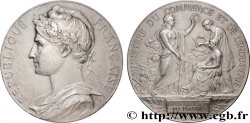
 Full data
Full data